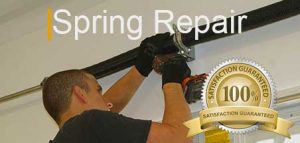How to Fix Garage Door Springs?
Garage doors are not just essential components of our homes; they play a crucial role in providing security and convenience. When issues arise with the springs and cables, it can be a major inconvenience, disrupting our daily routines and causing frustration. In this comprehensive guide, we’ll walk you through the step-by-step process of repairing garage door springs and cables safely and effectively, ensuring that you have the knowledge and confidence to tackle this task with ease. By following our detailed instructions and tips, you’ll be able to restore the smooth and reliable operation of your garage door, bringing peace of mind and convenience back into your life.

Tools and Materials Required
Before starting the repair process, gather these tools and materials:
- Adjustable wrench
- Clamps
- Cordless drill
- Hammer
- Leather gloves
- Locking pliers
- Rags
- Safety glasses
- Socket/ratchet set
- Winding bars
- Wrench set
- Bottom brackets
- Double-life torsion springs
- Lift cables
Understanding the Importance of Proper Repair
When it comes to garage door maintenance, one cannot underestimate the significance of handling springs and cables with care. These components are subjected to immense tension, and any mishandling can result in severe injury. Therefore, it is crucial to approach the repair process with utmost caution and respect for the potential dangers involved.
By following proper procedures and adhering to safety precautions, you not only ensure a successful repair but also safeguard yourself from unnecessary risks. Taking the time to thoroughly understand the mechanisms at play and implementing the appropriate techniques will contribute to a smoother and safer repair experience. Remember, prioritizing safety is key when working with garage door springs and cables.

Step-by-Step Repair Process
- First, make sure to clamp the garage door securely to the track to prevent any unexpected movement during the repair process. This can be done by using reliable locking pliers or clamps to firmly hold the door in place, ensuring a stable and safe working environment. By taking this precautionary step, you will have greater peace of mind and be able to focus on the repair task at hand with confidence.
- Loosen the Unbroken Spring: Insert a sturdy winding bar into the winding cone of the intact spring, making sure to securely hold the bar as you proceed. Gradually loosen the setscrews, allowing the spring to gradually release tension. This careful process ensures a safe and controlled adjustment of the spring.
- To safely release tension, it is recommended to use two winding bars. Insert the second winding bar and carefully unwind the spring quarter turn by quarter turn. This gradual approach ensures a controlled release and minimizes the risk of any sudden movements or accidents. Taking these precautions is crucial for maintaining a safe working environment.
- Remove Nuts and Bolts: Once the spring is loosened, carefully unscrew and remove the nuts and bolts that secure the stationary spring cones to the center bracket. By doing this, you will be able to slide the springs toward the end brackets, providing you with easier access and greater convenience during the process.
- Secure the Torsion Tube: Carefully utilize locking pliers or sturdy clamps to firmly secure the torsion tube in its designated position. Take a moment to ensure that it is tightly fastened, providing a stable foundation for the subsequent steps. Then, gently loosen the setscrews on the lift cable drums and carefully disconnect the lift cables, ensuring that they are completely detached before proceeding further.
- Slide the Torsion Tube Over: Carefully shift the torsion tube to one side, ensuring that it is securely moved to allow for the removal of the cable drum and old spring. It is important to handle these components with utmost caution and precision to prevent any potential injury or damage during the process. Take your time and follow these steps diligently to ensure a safe and successful removal.
- Calculate Wire Diameter: To accurately determine the wire diameter of the spring, carefully measure the individual coils using a caliper or a specialized measuring tool. This crucial information will play a vital role in the process of selecting the appropriate replacement springs for your specific needs.
- Reassemble and Hang on the Bearing Bracket: Begin by installing the new torsion spring, carefully aligning it with the designated slot. Then, reattach the cable drum, ensuring a secure connection. Gently insert the torsion bar into the bearing bracket, making sure it is properly seated. Take a moment to double-check that all components are precisely aligned and securely fastened, as this is crucial for optimal performance and safety.
- Install a New Center Bearing: Begin by connecting the stationary cones securely to the center bracket. Then, carefully install the new spring, ensuring that it is properly aligned and attached according to the manufacturer’s guidelines. Taking the time to follow these instructions will ensure a successful and efficient installation process.
- Deal with Rusted Parts: Take the time to carefully inspect your garage door system for any signs of rusted components. If you happen to come across any, it’s important to replace them promptly. By doing so, you can ensure that your garage door operates smoothly and efficiently, while also prolonging its overall lifespan. This attention to detail and maintenance will help keep your garage door in optimal condition for years to come.
- Anchor the Cable: Carefully run the lift cables between the rollers and doorjamb, making sure to anchor them securely in the designated slot on the drum. It is crucial to ensure proper cable alignment to guarantee the safe and effective operation of the mechanism. By taking the time to anchor the cables correctly, you can enhance the overall performance and longevity of the system while prioritizing the safety of the users.
- Tighten the Drums: To ensure equal tension on both sides of the door and prevent any uneven opening or closing, it is important to evenly tighten the drums. This will help maintain the proper balance and smooth functionality of the door, providing a more reliable and efficient operation.
- Wind the Springs: Using winding bars, carefully wind the springs following the specific recommendations provided by the manufacturer. It is crucial to follow these instructions precisely to ensure the optimal tension is achieved, ultimately resulting in the smooth and efficient operation of the mechanism. Take your time and exercise caution during this process to guarantee the utmost safety and effectiveness.
- Stretch the Springs: To optimize spring performance and ensure longevity, gently tap the winding bar to apply a slight stretch to the spring before tightening the setscrews. This important step helps to enhance the overall functionality and durability of the springs, allowing them to effectively support the intended load and maintain optimal performance over time.
- Lubricate the Springs: To ensure smooth and efficient operation of your garage door, it is important to apply a high-quality garage door lubricant to the springs. This helps reduce friction, minimizing wear and tear, and ultimately extends the lifespan of your garage door system. By regularly lubricating the springs, you can keep your garage door functioning optimally and prevent any potential issues that may arise from a lack of lubrication. Taking this simple step will help maintain the performance and longevity of your garage door for years to come.
- Test the Garage Door Tension: Start by lifting the door manually to evaluate the tension. Pay close attention to how the door behaves when you release it. If the door remains in place, it indicates that the spring tension is appropriately adjusted, contributing to safe and efficient operation. On the other hand, if the door moves or feels too heavy, it may require adjustments to the tension for optimal performance. Taking the time to ensure proper spring tension will not only enhance the door’s functionality but also promote a safer environment for its operation.
Maintaining a garage door requires meticulous attention to a variety of components, each essential for the door’s optimal performance and safety. By carefully stretching the springs before tightening, regularly lubricating them, and testing the door’s tension, you can ensure a smoothly functioning garage door system. These simple, yet vital, maintenance steps will not only extend the lifespan of the garage door but also enhance its operation and safety, providing peace of mind and convenience to homeowners. Remember that regular checks and maintenance are the keystones of a durable and reliable garage door system.
Questions and Answers
Q: How often should I lubricate the springs of my garage door to ensure optimal functioning?
A: To keep your garage door operating smoothly, it’s recommended to lubricate the springs regularly. The specific frequency can depend on the usage rate and the environmental conditions, but a good rule of thumb is to lubricate them at least once or twice a year.
Q: What is the significance of testing the garage door tension?
A: Testing the garage door tension is crucial because it ensures that the door is balanced and that the springs are properly adjusted. A well-tensioned door will remain in place when lifted manually, indicating safe and efficient operation. Conversely, if the door feels too heavy or moves when released, it may require a tension adjustment to optimize performance and safety.
Q: What can happen if the garage door springs are not properly maintained?
A: If the garage door springs are not properly maintained through regular stretching, lubrication, and tension testing, they can wear out more quickly, leading to potential operational issues. Lack of maintenance can result in a malfunctioning door, a a higher risk of accidents, and possibly costly repairs or replacements.
Q: Can homeowners perform garage door maintenance themselves, or should they call a professional?
A: Homeowners can perform some basic garage door maintenance tasks themselves, such as lubricating the springs and visually inspecting the system. However, tasks like adjusting the spring tension can be dangerous and are best left to professionals. When in doubt, it’s wise to consult a skilled technician to ensure safety and proper maintenance.
Q: What are the benefits of maintaining my garage door?
A: Regular maintenance of your garage door provides several benefits, including extended lifespan, improved functionality, and enhanced safety. By taking care of the door’s components, you reduce the likelihood of inconvenient breakdowns and costly repairs. Additionally, a well-maintained door offers improved security for your home and peace of mind.










